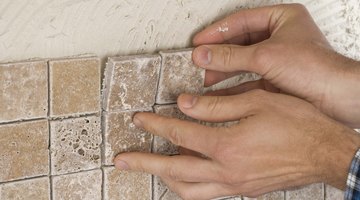Problems With Mapei Grout
Mapei manufactures grout and other products used to install floors and walls. Some problems with Mapei grout arise due to installation mistakes or the composition of the grout. You can avoid some pitfalls by carefully following Mapei’s application instructions.

Other problems subside with routine maintenance that preserves the appearance of the grout.
Efflorescence
The appearance of a chalky, white substance on the surface of grout is referred to as efflorescence. It occurs when water carries salt crystals to the surface of the grout as it dries. Efflorescence is particularly noticeable on dark-colored grout. In a list of the top causes of efflorescence, Mapei indicates that the problem often occurs when installers mix grout with too much water. Letting water puddle in the joints between tiles as grout is applied also causes efflorescence.
Porosity
Cement-based grout made by Mapei and other manufacturers tends to be porous after it dries. Porous grout has numerous tiny holes that absorb liquids and dirt, which makes light-colored grout look stained and dingy. In such cases, no amount of cleaning or scrubbing removes the absorbed dirt from the grout’s surface. Scrubbing may discolor a cement-based grout more if it absorbs colorants contained in a cleaner.
Leaching
Polymers in some colored Mapei grout may rise to the surface and create white spots due to leaching. A polymer is a compound that manufacturers add to grout to reduce porosity and improve stability, according to the Tile Council of North America. Like efflorescence, leaching can occur when grout is mixed with too much water. Polymers are often white, so white spots are left behind after the excess water evaporates.
Problem Solvers
Scrubbing grout with a stiff nylon brush moistened with clean water sometimes removes efflorescence. A grout haze remover intended to remove residue from tiles also may get rid of efflorescence on grout, according to Mapei. One of the easiest ways to eliminate white spots that result from polymer leaching is by covering the spots with a colored sealer that matches the grout. Apply a clear sealer to cement-based grout to prevent staining that results from the grout's porosity. Mapei notes that sealers need to be reapplied periodically to keep grout stain-free. Consider recoloring the grout with a colored sealer if it's already stained.
The Drip Cap
- Mapei manufactures grout and other products used to install floors and walls.
- In a list of the top causes of efflorescence, Mapei indicates that the problem often occurs when installers mix grout with too much water.
- One of the easiest ways to eliminate white spots that result from polymer leaching is by covering the spots with a colored sealer that matches the grout.
- Apply a clear sealer to cement-based grout to prevent staining that results from the grout's porosity.
References
Writer Bio
Frances Burks has more than 15 years experience in writing positions, including work as a news analyst for executive briefings and as an Associated Press journalist. Burks has banking and business development experience, and she has written numerous articles on consumer issues and home improvement. Burks holds a bachelor's degree in political science from the University of Michigan.
Photo Credits
- Jupiterimages/Comstock/Getty Images
- Jupiterimages/Comstock/Getty Images
More Articles



